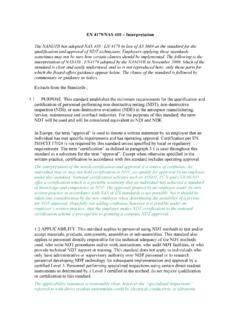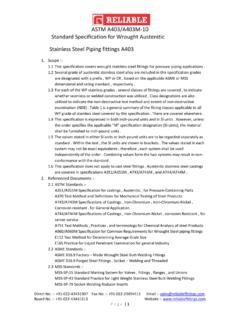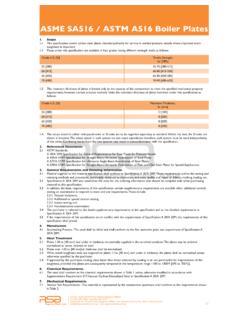Transcription of BEST PRACTICE FOR THE PROCUREMENT AND …
1 best PRACTICE FOR THE PROCUREMENT ANDCONDUCT OF NON- destructive TESTINGPart 1: Manual ultrasonic InspectionGAS AND PROCESS SAFETYTECHNOLOGY DIVISIONN ovember 2000 The recommendations contained in this document were aimed specifically to improve theinspection of conventional pressurised equipment. However, the drafting committeeconsiders that these measures can also apply to any application of manual ultrasonicinspection including fairground or railway components, offshore equipment, and conventionalplant in nuclear BainbridgeGas and Process SafetyTechnology DivisionHealth and Safety Executive1.
2 INTRODUCTIONIt is widely recognised that NDT can be less effective than anticipated by those applying it orby those using the results to determine component integrity. This has been confirmed in anumber of trials and most recently, for manual ultrasonic in-service inspection1, by the PANI project [Ref. 1]. Consequently, the Health and Safety Executive (HSE) has judged itappropriate to issue the recommendations of the PANI committee, which identify whenproblems can arise in the application of NDT and what solutions might be measures contained in this document are recommended by the HSE for the conduct ofmanual ultrasonic inspection.
3 They are intended to promote the adoption of good PRACTICE andapply to in-service inspection of existing plant or to repairs. The measures could also beapplicable to the inspections carried out during the manufacture of new or replacement apply both to inspections carried out by the NDT department of the company owning ormanufacturing the plant and to those carried out by external NDT organisations undercontract. In the latter case, they are intended to assist in the PROCUREMENT process byhighlighting the issues that need document has been drawn up by a committee of experts assembled by the HSE for thispurpose.
4 Their names and affiliations are given in Appendix 1, from which it will be apparentthat they represent a very wide range of those parts of UK industry using the relevant NDTmethods. In addition, they have considerable expertise in and responsibility for the applicationof NDT to industrial plant. The recommendations contained in this document are based ontwo main sources. The first is the recently completed PANI exercise mentioned above. Thiswas an HSE-funded project involving the application of manual ultrasonic methods used forin-service inspection to test-pieces, containing defects, representing a range of typicalindustrial plant items.
5 The inspections were carried out as they would be in PRACTICE and theresults have great significance in assessing the performance to be expected of current methodsas well as in identifying areas and means for improvement. These measures represent animmediate application of the results of the PANI project pending a more protractedinvestigation of the issues raised. The second basis for the recommendations is the collectiveexperience and expertise of the committee mentioned earlier. Many of the members were alsomembers of the PANI Management 2 contains a review of the current way in which most manual ultrasonic inspectionsare designed and carried out and the way in which the quality of the inspection is assured.
6 Theinspection methods examined in the PANI project were developed using this 3 continues with an analysis of potential problems together with a list of the measureswhich can be adopted in response. In doing this, it is recognised that the extent to which it isreasonable to include additional features in the inspection, and incur additional costs as aresult, depends on the role of the inspection in assuring plant safety, the economics of theinspection activity and the consequences of the inspection failing to achieve its , Section 4 contains recommendations on how the effectiveness required of theinspection can be assessed and on how this then affects the adoption of the additionalinspection measures identified in Section The term inspection is commonly used to mean both NDT and inspection in its widersense.
7 Throughout this document, it is used to mean CURRENT PRACTICEMany manual ultrasonic inspections are designed on the basis of a national or internationalstandard such as BS EN 1714 [Ref. 2]. The procedure for the inspection is written to simplyreflect the requirements of the standard in terms of the beam angles, scanning patterns,sensitivities, probe types and so on. Often no account is taken in this approach of the detail ofthe defects which the inspection is intended to detect and may be trained and qualified according to the requirements of a qualificationscheme based on international standards such as BS EN 473 [Ref.]
8 3] or ISO 9712 [Ref. 4].These typically require operators to pass a written examination and to demonstrate theirpractical skill on test pieces containing defects. Of necessity, the test pieces cover a limitedrange of geometries and contain a limited range of defect types. This means that the testpieces on which an operator qualified may not be directly relevant to a particular addition, many qualification schemes concentrate on defect detection and lengthmeasurement. There is less emphasis on the measurement of defect through-wall size and soan operator s ability to carry out such measurements is not fully authority to approve a procedure for a specific inspection based on the more generalrequirements of a code or standard requires skills and qualifications additional to thoserequired of the operators who apply the inspection in the field.
9 Such qualifications aredenoted as ultrasonic testing (UT) Level 3 and involve demonstrating a greaterunderstanding of the particular inspection method than expected of the Level 1 or 2 operatorswho normally carry out the inspection. As an example to illustrate this point, completedefinitions, for one particular qualification scheme, of the areas in which operators at Levels1, 2 and 3 have demonstrated competence and the tasks they are qualified to perform aregiven in Appendix 2. These are taken from the documentation of the UK PCN scheme [ ]which complies with the requirements of BS EN approach outlined above can be effective in certain circumstances and represents a costeffective way of defining and implementing requirements for manual ultrasonic , there are circumstances in which it can lead to the adoption of unsatisfactoryinspection procedures or to the use of operators whose training and qualifications areinappropriate to the particular inspection.
10 It is crucial that such circumstances are recognisedand appropriate additional requirements are specified. The PANI programme illustrated thepotential shortcomings of the uncritical adoption of the approach described above andhighlighted the situations where additional measures are needed. These are discussed THE NEED FOR ADDITIONAL REQUIREMENTSIn this Section, the issues highlighted by the PANI project are discussed along with othersidentified by the committee of experts described in the Introduction. In each case, theproblems discussed are followed by a number of recommendations to address the particulardifficulty.













